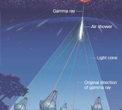The CERENKOV TELEscope Array

In 1912, Victor Hess took a ballon ride to escape the natural radiation he had observed at ground level. To his surprise, rather than go away, the radiation he saw increased. Such was the discovery of cosmic rays - radiation from space that the Earth’s atmosphere largely protects us from.
In 1930, Pierre Auger discovered the particle showers - energetic particles from space, impacting our atmosphere and generating cascades of lower energy secondary particles. These secondary particles can excite molecules of nitrogen in the atmosphere, which then de-excite (fluoresce) with the emission of light. If the particles travel faster than the local speed of light (light travels slower in a medium such as the atmosphere; it has a refractive index) then Cerenkov light is also radiated.
What are the characteristics of cosmic rays, and what are their origin?
Well, it turns out that much of the ‘lower’ energy radiation comes from our Sun. Some of this, caught in the Earth’s magnetic field, is responsible for the aurora. But the Sun is a relatively quiescent source of radiation. Detailed measurements have found an almost perfectly logarithmically falling energy spectrum of events, extending up to incredibly high energies. The higher energy particles must come from more violent (and arguably interesting!) sources. The Cerenkov Telescope Array proposes to use these the particles as probes of the high energy Universe, a unique tool, and a new wavelength for astronomy.
We’ve at the Project Preparation stage, which is technobable for somewhere between design and full construction.

a new probe of the high energy universe
The Cerenkov Telescope Array will open a new window on the Universe, for the first time blah...



